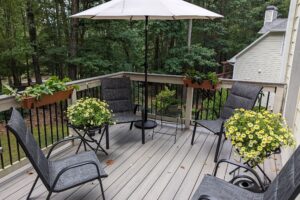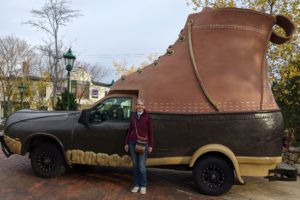Various locations along the Atlantic Ocean and the Gulf Coast are home to sea turtle rescue stations, or recovery hospitals. One of these rescue places is on Jekyll Island. We knew so little about these valuable places so were glad to walk through and learn. This brick building used to be the power station for the island.


original power plant building

Plans to convert the club from gas lights to electric began in 1892 for after the end of the 1893-1894 winter season. However, a yellow fever epidemic in Brunswick, just south of here, resulted in the club being closed that year. This closure meant the club didn’t have the funds to complete planned improvements. A financial panic in May 1894 further delayed construction.
Finally in 1902 the club contracted with a company to build the power plant and install 2 coal-fired Westinghouse generators. When members arrived in January 1903, for the first time they were greeted with the warm glow of electric lights throughout the Club House and the surrounding landscape.
power house to sea turtles



Sea turtles are large, ocean-dwelling reptiles that have lungs and need to breathe air on the surface.

Since they don’t have diaphragms, sea turtles flap their flippers to cause pressure changes within the lung cavity; this movement helps with both breathing in and out.

Because they are so efficient at oxygen exchange, sea turtles can remain underwater for hours, depending on their activity level.
welcome to the center

The Georgia coast, less than 100 miles long, has an outstanding diversity of life. Without a mainland coastline, the state’s unique series of barrier islands, productive salt marshes, and nutrient-rich tidal seas provide habitats for an abundance of marine and coastal wildlife.

This center is one of only a few “turtle hospitals” in the U.S. The center provides veterinary care for sea turtles along the Atlantic Coast.

Scientists studying DNA have determined that female loggerheads nesting from northern Florida up to Virginia belong to a genetically distant population from those turtles nesting in other areas of Florida. This northern group is critically important to the recovery of loggerhead sea turtles.

5 species of local sea turtles

- Loggerhead. Named for their large skull and crushing jaws, their reddish-orange “shell” is often covered with living organisms that love to ride along. (More about these organisms toward the end of this post.)

2. Green. This turtle has a small, slender head and serrated lower beak. The shell is brown, not green. They get their name from the color of their body fat and muscle that is tinted from a consistent diet of algae and sea grasses.

3. Leatherback. The deepest diving reptile, leatherbacks have a flexible “shell” and thick layers of fat to insulate them from heat loss. Their rigid respiratory pathways (similar to other deep diving marine mammals) allow them to venture nearly 4000 feet below the ocean’s surface.

Leatherbacks often feed in cold northern waters and then migrate thousands of miles to nest on warm, tropical beaches, such as those in the Caribbean. A few leatherneck nests (1 to 5 a year) are found on Georgia’s beaches.
4. Kemp’s Ridley. These are the smallest of all marine turtles. Their “shells” are a dull, grayish brown and are nearly circular in shape. Though they are the most abundant turtle in Georgia’s coastal waters, nearly all females nest in large groups on a single beach in Rancho Nuevo, Mexico.

In 1947, an estimated 40,000 females nested in a single day, but by 1994, that number had dropped to fewer than 350 nesting females a year, making them the most critically endangered sea turtles in the world. With conservation efforts, the nesting numbers is now up to 12,000 annually.
5. Hawksbill. These sea turtles were named for their narrow skull and bird-like beak that they use to dine on a specialized diet of sponges.
Hawksbills live worldwide in tropical seas where they play an important role in maintaining the health of coral reefs because their diet of sponges helps to maintain the balance between these sponges and the coral.

They have been hunted almost to extinction for their beautiful yellow and brown “tortoise” shells used to make jewelry and other products.
sea turtle nests
The best nests for sea turtles are above high tide lines to protect them from ocean waves and roots from vegetation close to the forest edge.

1, Below high tide line: eggs can be washed away by the tides and water can penetrate the eggs and drown the developing embryo
2. Underneath artificial light: while incubation isn’t affected by artificial lights, when the eggs hatch, the hatchlings can become mis-oriented and walk toward the stronger light rather than the light of the ocean at night
3. Nests in vegetation: plant roots can invade these nests and they can be found more easily by raccoons or feral hogs
Warm sand acts as a nursery ground for the vulnerable eggs during the 60 days it takes for them to develop. Reptilian eggs are soft and leathery, resembling slimy ping-pong balls. The embryo grows as it receives nourishment from its yolk sac and breathes through the thin, porous shell. I wish we would have been able to get a cut-away picture of these eggs in a nest but the glare was too much. It seemed as though 50 or so eggs were in the nest dug into the sand.


Leaving at night may help them evade hungry predators and keep them from drying out in the sun. Getting all of the hatchlings to the water may last for several days as they instinctively find the sea and swim to deep water.
We found it so interesting that this whole process was into their DNA millions of years ago.
As we’ve said, artificial light can create a problem for these young turtles.

However, bright, artificial lights can mis-orient them on their journey, often leading them into harm’s way. Even the bright sky glow from distant city lights can confuse them.
So how do we help? During mid-July if you’re on one of their nesting beaches, turn out bright porch or outdoor lights that can be seen from the beach. Cover flashlights with “turtle-friendly” red film, or better yet, leave flashlights at home and walk by the light of the moon.
male or female?

Since sea turtles lack sex chromosomes, the hatchlings’ gender is determined by the temperature of the sand. Warmer incubation conditions produce females, while cooler temperatures result in male hatchlings. Makes sense to me because I seek warm weather while Barney likes the temperature cooler.

The critical period of gender determination is in the middle third of incubation, at approximately 20-40 days. Other external factors can determine gender too, such as a heavy rain, a heat wave, or even the shade from a tall building.
migration
Sea turtles migrate to 4 different areas.

sargassum – The protection of the Sargasso Sea provides a place to hide and plenty of small prey items to feed upon. We’ll look at this more in depth.

Azores – the North Atlantic subtropical gyre can take the sea turtles to this series of islands in the eastern North Atlantic
Caribbean Sea – this gyre close to the sargassum can take the sea turtles to the warm Caribbean water.
Are some of these terms unfamiliar to you too? Let’s learn about them.
Sargassum is large brown algae with berrylike, gas-filled bladders that support flotation. It moves with an ocean current and forms large mats of floating ecosystems in the North Atlantic Ocean. This area is referred to as the Sargasso Sea, and it cover nearly 5 million square kilometers of open ocean (3,106,856 miles).

Okay, I don’t know what “carbon sequestration” is so I looked it up: “the long-term removal, capture or sequestration of carbon dioxide from the atmosphere to slow or reverse atmospheric CO2 pollution and to mitigate or reverse global warming. Carbon dioxide (CO2) is naturally captured from the atmosphere through biological, chemical, and physical processes.”
I feel smarter now.


Gyre is most frequently used as an oceanographic term that refers to vast circular systems of ocean currents, such as the North Atlantic Gyre, a system of currents circling clockwise between Europe, Africa, and the Americas.
The 5 major gyres are the North and South Pacific Subtropical Gypres, the North and South Atlantic Subtropical Gyres, and the Indian Ocean Subtropical Gyre.

lab for sea turtle rescue
The center is primarily know for the rescue work they do for hurt sea turtles. From 2010-2015, around 76% of sea turtle strandings (or beachings) in Georgia were caused by human activities, such as commercial fishing and boat strikes.


survival time for each stage of life
Hatchlings must avoid many natural predators and human activity on the beach that keeps them from reaching the ocean. With luck, they’ll reach the currents of the Sargasso Sea.
Juvenile: In the Sargasso Sea, the sea turtles will live and grow for the next 10-12 years. Then they’ll return to shallow coastal waters and feed on bottom-dwelling invertebrates for over a decade.

Sub-Adult: If still living after 3 decades of avoiding hazards, they’ll move to deeper waters as a sub-adult sea turtle.
Adult: At approximately 34 years of age, the sea turtle has reach its reproductive maturity and returns to the region where they were born to mate and nest. They may even live longer than most humans.
catching a ride on loggerheads
Loggerhead sea turtles are often joined by others who want to ride along.
Barnacles normally grow on the “shell” of loggerheads and horseshoe crab shells.
Columbus crab has its best quality habitat on the loggerhead where they are larger than they are when found living elsewhere in the marine environment.

Species of sea anemone have also been found living on the loggerhead shell. Interestingly, a loggerhead with 3 propeller scars across the shell had about 200 sea anemones in the 1-inch deep defect.
Several leech species have been found on loggerheads, especially when they are ill. These leeches actually suck blood and can transmit various disease agents. They can be treated by placing the turtle in a freshwater bath.
trash
Dumping our trash in the ocean creates horrible problems for the sea turtles (and others).



a solution
Trawl nets are used in coastal waters to catch shrimp and other marine animals, but they also catch everything in their path, including sea turtles. While a resting turtle may be able to go without air for 30 minutes or more, struggling in a net reduces the time significantly that a turtle can survive underwater.

box turtles
Box turtles are the common land turtles in the Eastern United States. They get their name from their ability to pull their limbs and head completely into their shells because of a specialized hinge on the bottom of the shell.

We got to see these box turtles in their home settings when we were staying at Georgia’s state parks earlier this year during our Covid-19 trips from May to July.

If they’ve been removed from their home, they’ll spend all their time trying to find their way back, which means they’ll cross roadways. So be careful when driving, and never move box turtles far from where you find them or try to take them home with you.
Hurt box turtles are also helped here.
rehab pavilion
Behind the education center where we’ve been is the Rehabilitation Pavilion where the real work is done.





fact sheets
Each sea turtle has a fact sheet that lets us know about what is happening.


Since opening the center in 2007, the center has released a number of sea turtles.

Now that we’ve seen the island as it is today, let’s go back to the museum and learn about the island’s history.




